Report: Marketing Communication Strategies for Sainsbury's Supermarket
VerifiedAdded on 2019/12/03
|8
|2369
|503
Report
AI Summary
This report provides a comprehensive analysis of Sainsbury's marketing communication, focusing on its market position and the challenges it faces in the UK supermarket industry. It begins with an overview of the company, its history, and its current standing as the third-largest supermarket chain in the UK, highlighting its declining market share and customer loyalty. The report then delves into an analysis of Sainsbury's external and internal environments using the STEEPLE and McKinsey 7-S models, identifying key factors influencing its performance. A major problem identified is the ineffectiveness of Sainsbury's customer relationship management (CRM) strategy, leading to decreased customer satisfaction and market share. The report concludes by discussing the implications of these issues and suggests strategies to improve CRM, retain customers, and regain market competitiveness. It emphasizes the importance of adapting to changing customer preferences, utilizing technology, and fostering ethical business practices to ensure long-term success. The report includes references to relevant academic sources.
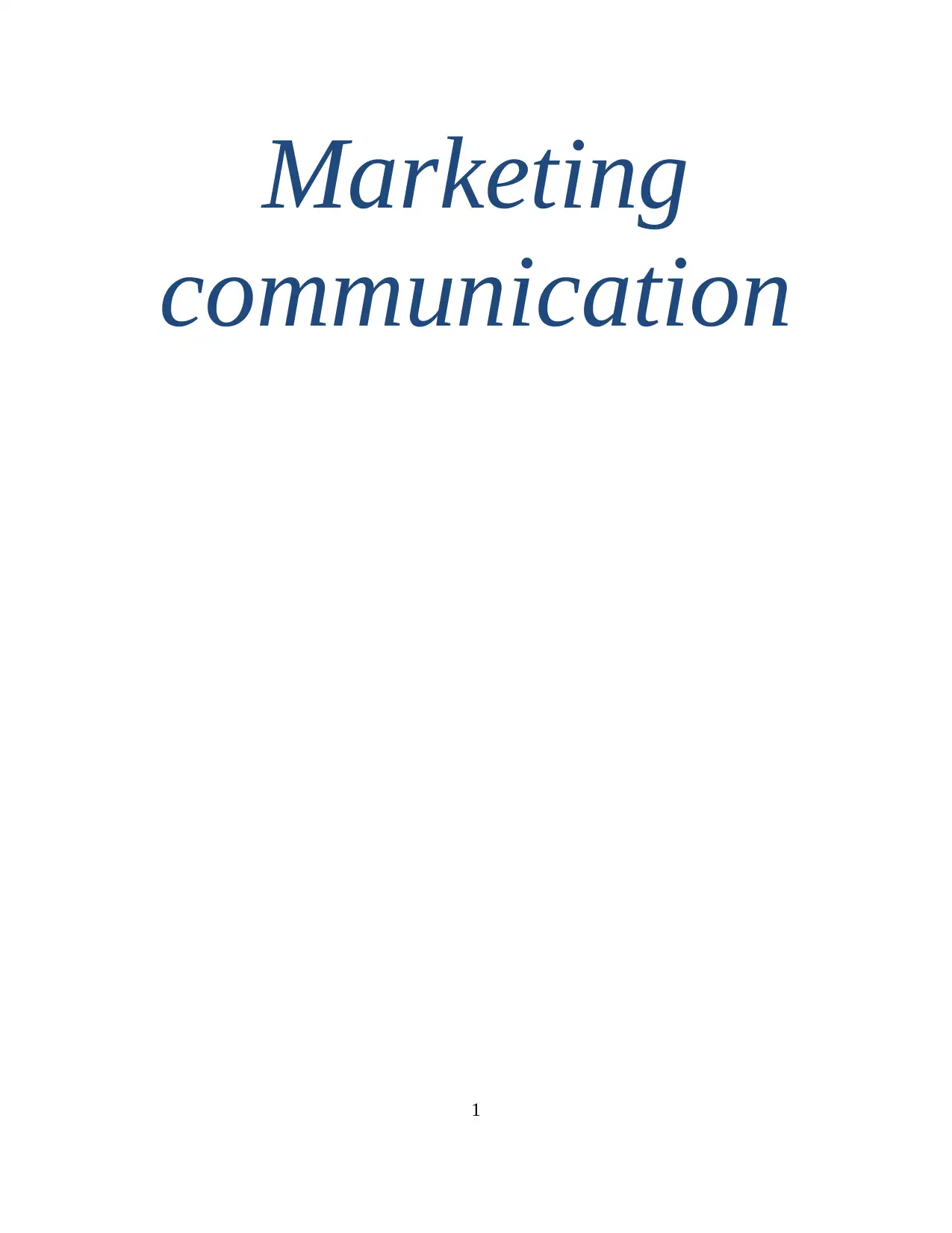
Marketing
communication
1
communication
1
Paraphrase This Document
Need a fresh take? Get an instant paraphrase of this document with our AI Paraphraser
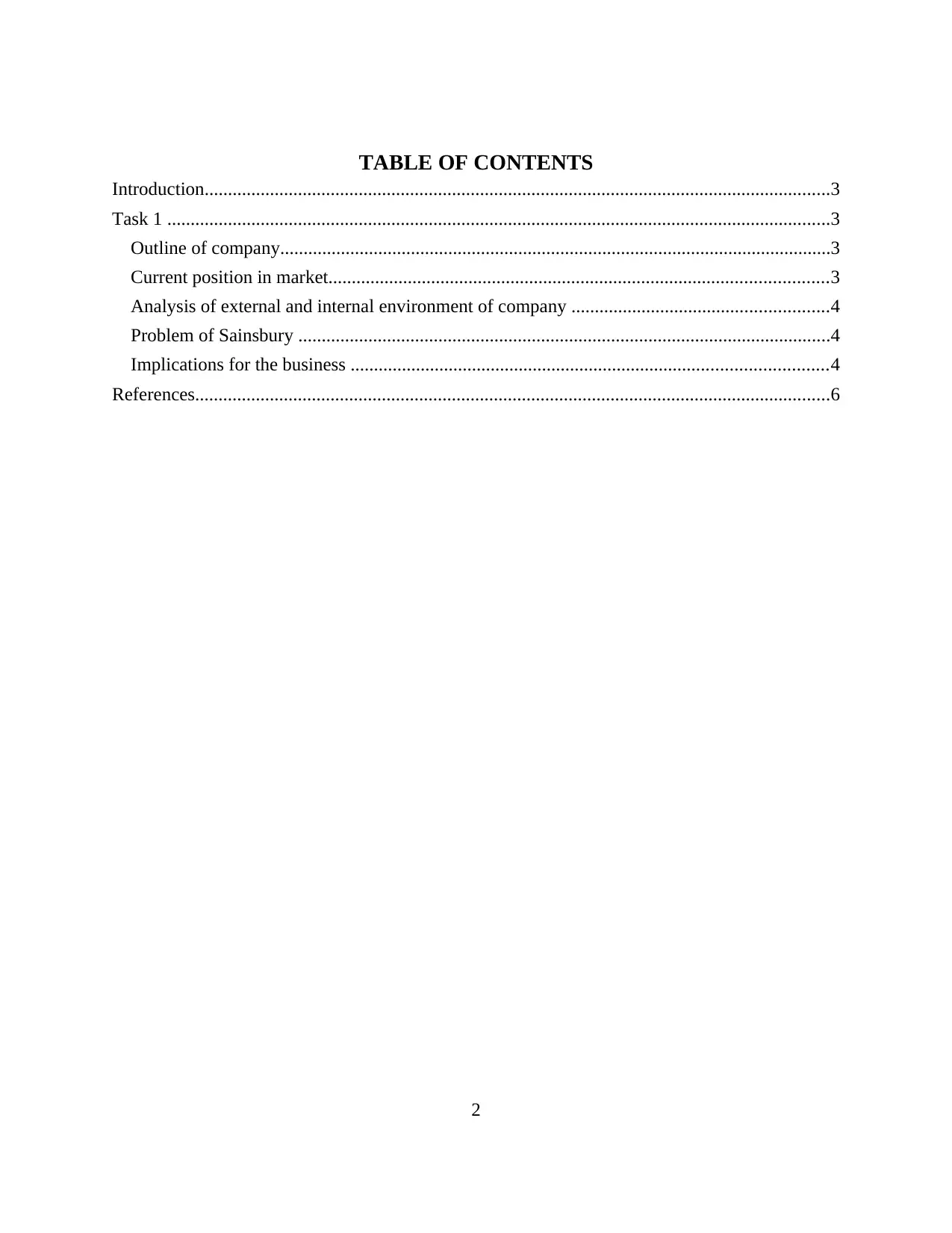
TABLE OF CONTENTS
Introduction......................................................................................................................................3
Task 1 ..............................................................................................................................................3
Outline of company......................................................................................................................3
Current position in market...........................................................................................................3
Analysis of external and internal environment of company .......................................................4
Problem of Sainsbury ..................................................................................................................4
Implications for the business ......................................................................................................4
References........................................................................................................................................6
2
Introduction......................................................................................................................................3
Task 1 ..............................................................................................................................................3
Outline of company......................................................................................................................3
Current position in market...........................................................................................................3
Analysis of external and internal environment of company .......................................................4
Problem of Sainsbury ..................................................................................................................4
Implications for the business ......................................................................................................4
References........................................................................................................................................6
2
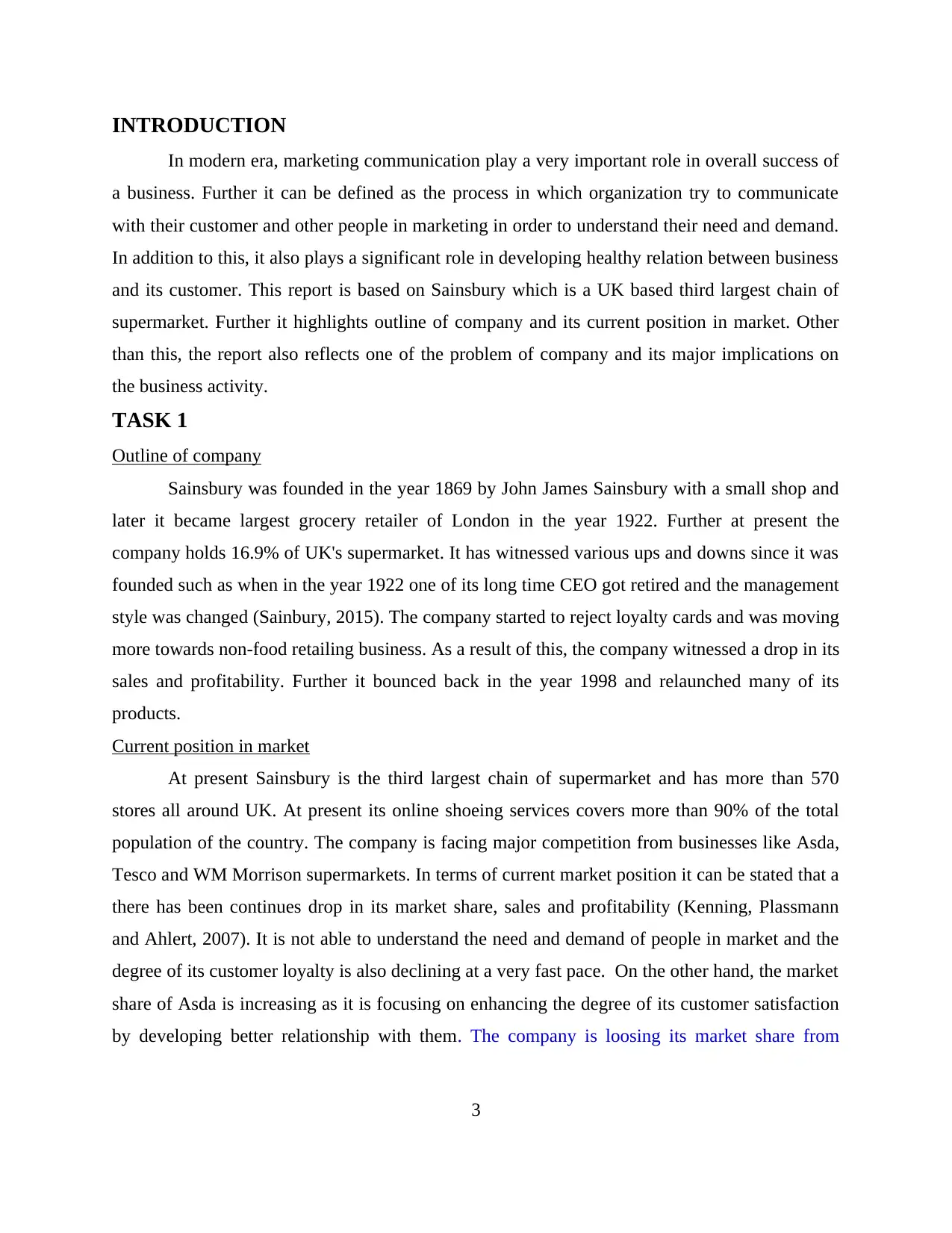
INTRODUCTION
In modern era, marketing communication play a very important role in overall success of
a business. Further it can be defined as the process in which organization try to communicate
with their customer and other people in marketing in order to understand their need and demand.
In addition to this, it also plays a significant role in developing healthy relation between business
and its customer. This report is based on Sainsbury which is a UK based third largest chain of
supermarket. Further it highlights outline of company and its current position in market. Other
than this, the report also reflects one of the problem of company and its major implications on
the business activity.
TASK 1
Outline of company
Sainsbury was founded in the year 1869 by John James Sainsbury with a small shop and
later it became largest grocery retailer of London in the year 1922. Further at present the
company holds 16.9% of UK's supermarket. It has witnessed various ups and downs since it was
founded such as when in the year 1922 one of its long time CEO got retired and the management
style was changed (Sainbury, 2015). The company started to reject loyalty cards and was moving
more towards non-food retailing business. As a result of this, the company witnessed a drop in its
sales and profitability. Further it bounced back in the year 1998 and relaunched many of its
products.
Current position in market
At present Sainsbury is the third largest chain of supermarket and has more than 570
stores all around UK. At present its online shoeing services covers more than 90% of the total
population of the country. The company is facing major competition from businesses like Asda,
Tesco and WM Morrison supermarkets. In terms of current market position it can be stated that a
there has been continues drop in its market share, sales and profitability (Kenning, Plassmann
and Ahlert, 2007). It is not able to understand the need and demand of people in market and the
degree of its customer loyalty is also declining at a very fast pace. On the other hand, the market
share of Asda is increasing as it is focusing on enhancing the degree of its customer satisfaction
by developing better relationship with them. The company is loosing its market share from
3
In modern era, marketing communication play a very important role in overall success of
a business. Further it can be defined as the process in which organization try to communicate
with their customer and other people in marketing in order to understand their need and demand.
In addition to this, it also plays a significant role in developing healthy relation between business
and its customer. This report is based on Sainsbury which is a UK based third largest chain of
supermarket. Further it highlights outline of company and its current position in market. Other
than this, the report also reflects one of the problem of company and its major implications on
the business activity.
TASK 1
Outline of company
Sainsbury was founded in the year 1869 by John James Sainsbury with a small shop and
later it became largest grocery retailer of London in the year 1922. Further at present the
company holds 16.9% of UK's supermarket. It has witnessed various ups and downs since it was
founded such as when in the year 1922 one of its long time CEO got retired and the management
style was changed (Sainbury, 2015). The company started to reject loyalty cards and was moving
more towards non-food retailing business. As a result of this, the company witnessed a drop in its
sales and profitability. Further it bounced back in the year 1998 and relaunched many of its
products.
Current position in market
At present Sainsbury is the third largest chain of supermarket and has more than 570
stores all around UK. At present its online shoeing services covers more than 90% of the total
population of the country. The company is facing major competition from businesses like Asda,
Tesco and WM Morrison supermarkets. In terms of current market position it can be stated that a
there has been continues drop in its market share, sales and profitability (Kenning, Plassmann
and Ahlert, 2007). It is not able to understand the need and demand of people in market and the
degree of its customer loyalty is also declining at a very fast pace. On the other hand, the market
share of Asda is increasing as it is focusing on enhancing the degree of its customer satisfaction
by developing better relationship with them. The company is loosing its market share from
3
⊘ This is a preview!⊘
Do you want full access?
Subscribe today to unlock all pages.

Trusted by 1+ million students worldwide
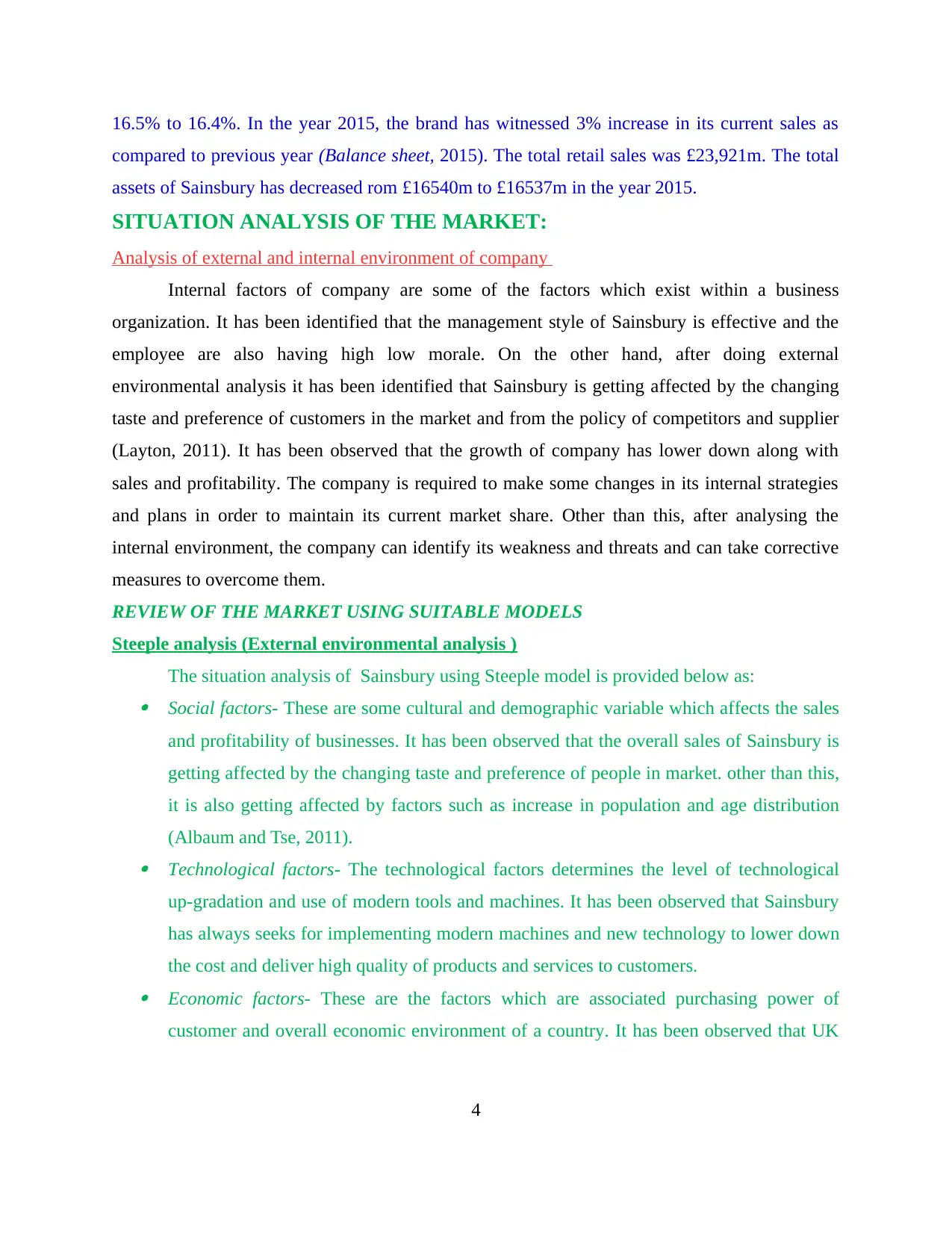
16.5% to 16.4%. In the year 2015, the brand has witnessed 3% increase in its current sales as
compared to previous year (Balance sheet, 2015). The total retail sales was £23,921m. The total
assets of Sainsbury has decreased rom £16540m to £16537m in the year 2015.
SITUATION ANALYSIS OF THE MARKET:
Analysis of external and internal environment of company
Internal factors of company are some of the factors which exist within a business
organization. It has been identified that the management style of Sainsbury is effective and the
employee are also having high low morale. On the other hand, after doing external
environmental analysis it has been identified that Sainsbury is getting affected by the changing
taste and preference of customers in the market and from the policy of competitors and supplier
(Layton, 2011). It has been observed that the growth of company has lower down along with
sales and profitability. The company is required to make some changes in its internal strategies
and plans in order to maintain its current market share. Other than this, after analysing the
internal environment, the company can identify its weakness and threats and can take corrective
measures to overcome them.
REVIEW OF THE MARKET USING SUITABLE MODELS
Steeple analysis (External environmental analysis )
The situation analysis of Sainsbury using Steeple model is provided below as: Social factors- These are some cultural and demographic variable which affects the sales
and profitability of businesses. It has been observed that the overall sales of Sainsbury is
getting affected by the changing taste and preference of people in market. other than this,
it is also getting affected by factors such as increase in population and age distribution
(Albaum and Tse, 2011). Technological factors- The technological factors determines the level of technological
up-gradation and use of modern tools and machines. It has been observed that Sainsbury
has always seeks for implementing modern machines and new technology to lower down
the cost and deliver high quality of products and services to customers. Economic factors- These are the factors which are associated purchasing power of
customer and overall economic environment of a country. It has been observed that UK
4
compared to previous year (Balance sheet, 2015). The total retail sales was £23,921m. The total
assets of Sainsbury has decreased rom £16540m to £16537m in the year 2015.
SITUATION ANALYSIS OF THE MARKET:
Analysis of external and internal environment of company
Internal factors of company are some of the factors which exist within a business
organization. It has been identified that the management style of Sainsbury is effective and the
employee are also having high low morale. On the other hand, after doing external
environmental analysis it has been identified that Sainsbury is getting affected by the changing
taste and preference of customers in the market and from the policy of competitors and supplier
(Layton, 2011). It has been observed that the growth of company has lower down along with
sales and profitability. The company is required to make some changes in its internal strategies
and plans in order to maintain its current market share. Other than this, after analysing the
internal environment, the company can identify its weakness and threats and can take corrective
measures to overcome them.
REVIEW OF THE MARKET USING SUITABLE MODELS
Steeple analysis (External environmental analysis )
The situation analysis of Sainsbury using Steeple model is provided below as: Social factors- These are some cultural and demographic variable which affects the sales
and profitability of businesses. It has been observed that the overall sales of Sainsbury is
getting affected by the changing taste and preference of people in market. other than this,
it is also getting affected by factors such as increase in population and age distribution
(Albaum and Tse, 2011). Technological factors- The technological factors determines the level of technological
up-gradation and use of modern tools and machines. It has been observed that Sainsbury
has always seeks for implementing modern machines and new technology to lower down
the cost and deliver high quality of products and services to customers. Economic factors- These are the factors which are associated purchasing power of
customer and overall economic environment of a country. It has been observed that UK
4
Paraphrase This Document
Need a fresh take? Get an instant paraphrase of this document with our AI Paraphraser
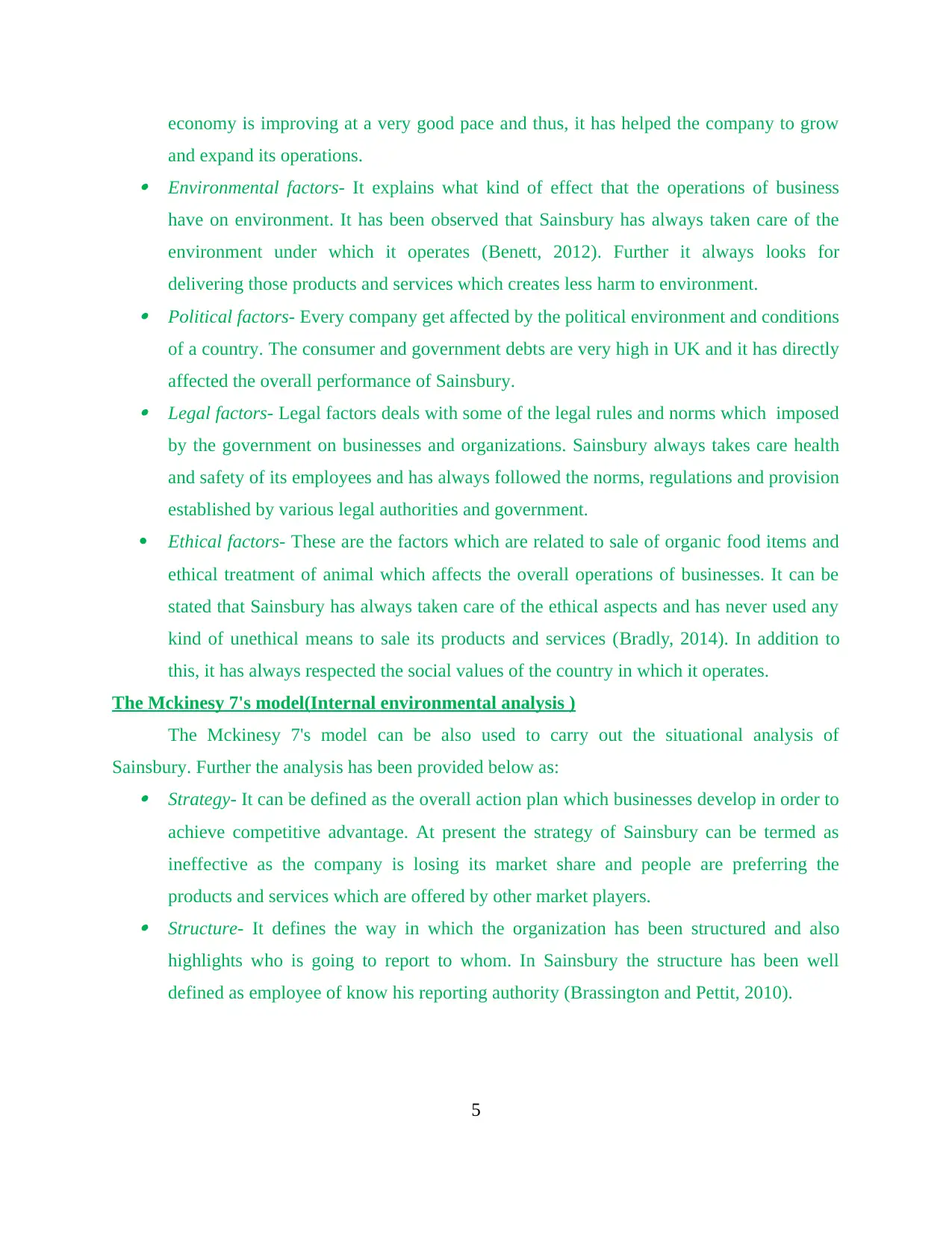
economy is improving at a very good pace and thus, it has helped the company to grow
and expand its operations. Environmental factors- It explains what kind of effect that the operations of business
have on environment. It has been observed that Sainsbury has always taken care of the
environment under which it operates (Benett, 2012). Further it always looks for
delivering those products and services which creates less harm to environment. Political factors- Every company get affected by the political environment and conditions
of a country. The consumer and government debts are very high in UK and it has directly
affected the overall performance of Sainsbury. Legal factors- Legal factors deals with some of the legal rules and norms which imposed
by the government on businesses and organizations. Sainsbury always takes care health
and safety of its employees and has always followed the norms, regulations and provision
established by various legal authorities and government.
Ethical factors- These are the factors which are related to sale of organic food items and
ethical treatment of animal which affects the overall operations of businesses. It can be
stated that Sainsbury has always taken care of the ethical aspects and has never used any
kind of unethical means to sale its products and services (Bradly, 2014). In addition to
this, it has always respected the social values of the country in which it operates.
The Mckinesy 7's model(Internal environmental analysis )
The Mckinesy 7's model can be also used to carry out the situational analysis of
Sainsbury. Further the analysis has been provided below as: Strategy- It can be defined as the overall action plan which businesses develop in order to
achieve competitive advantage. At present the strategy of Sainsbury can be termed as
ineffective as the company is losing its market share and people are preferring the
products and services which are offered by other market players. Structure- It defines the way in which the organization has been structured and also
highlights who is going to report to whom. In Sainsbury the structure has been well
defined as employee of know his reporting authority (Brassington and Pettit, 2010).
5
and expand its operations. Environmental factors- It explains what kind of effect that the operations of business
have on environment. It has been observed that Sainsbury has always taken care of the
environment under which it operates (Benett, 2012). Further it always looks for
delivering those products and services which creates less harm to environment. Political factors- Every company get affected by the political environment and conditions
of a country. The consumer and government debts are very high in UK and it has directly
affected the overall performance of Sainsbury. Legal factors- Legal factors deals with some of the legal rules and norms which imposed
by the government on businesses and organizations. Sainsbury always takes care health
and safety of its employees and has always followed the norms, regulations and provision
established by various legal authorities and government.
Ethical factors- These are the factors which are related to sale of organic food items and
ethical treatment of animal which affects the overall operations of businesses. It can be
stated that Sainsbury has always taken care of the ethical aspects and has never used any
kind of unethical means to sale its products and services (Bradly, 2014). In addition to
this, it has always respected the social values of the country in which it operates.
The Mckinesy 7's model(Internal environmental analysis )
The Mckinesy 7's model can be also used to carry out the situational analysis of
Sainsbury. Further the analysis has been provided below as: Strategy- It can be defined as the overall action plan which businesses develop in order to
achieve competitive advantage. At present the strategy of Sainsbury can be termed as
ineffective as the company is losing its market share and people are preferring the
products and services which are offered by other market players. Structure- It defines the way in which the organization has been structured and also
highlights who is going to report to whom. In Sainsbury the structure has been well
defined as employee of know his reporting authority (Brassington and Pettit, 2010).
5
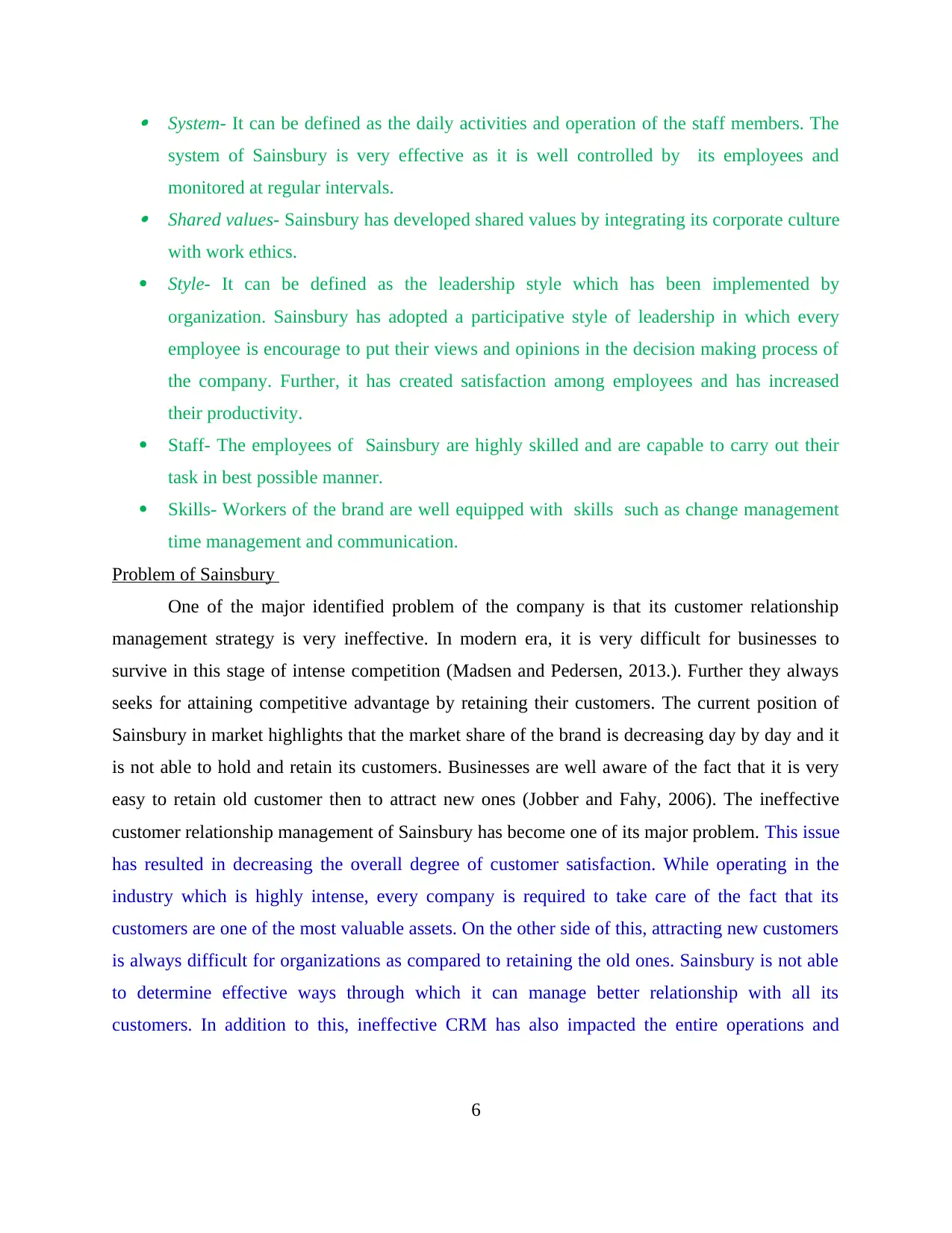
System- It can be defined as the daily activities and operation of the staff members. The
system of Sainsbury is very effective as it is well controlled by its employees and
monitored at regular intervals. Shared values- Sainsbury has developed shared values by integrating its corporate culture
with work ethics.
Style- It can be defined as the leadership style which has been implemented by
organization. Sainsbury has adopted a participative style of leadership in which every
employee is encourage to put their views and opinions in the decision making process of
the company. Further, it has created satisfaction among employees and has increased
their productivity.
Staff- The employees of Sainsbury are highly skilled and are capable to carry out their
task in best possible manner.
Skills- Workers of the brand are well equipped with skills such as change management
time management and communication.
Problem of Sainsbury
One of the major identified problem of the company is that its customer relationship
management strategy is very ineffective. In modern era, it is very difficult for businesses to
survive in this stage of intense competition (Madsen and Pedersen, 2013.). Further they always
seeks for attaining competitive advantage by retaining their customers. The current position of
Sainsbury in market highlights that the market share of the brand is decreasing day by day and it
is not able to hold and retain its customers. Businesses are well aware of the fact that it is very
easy to retain old customer then to attract new ones (Jobber and Fahy, 2006). The ineffective
customer relationship management of Sainsbury has become one of its major problem. This issue
has resulted in decreasing the overall degree of customer satisfaction. While operating in the
industry which is highly intense, every company is required to take care of the fact that its
customers are one of the most valuable assets. On the other side of this, attracting new customers
is always difficult for organizations as compared to retaining the old ones. Sainsbury is not able
to determine effective ways through which it can manage better relationship with all its
customers. In addition to this, ineffective CRM has also impacted the entire operations and
6
system of Sainsbury is very effective as it is well controlled by its employees and
monitored at regular intervals. Shared values- Sainsbury has developed shared values by integrating its corporate culture
with work ethics.
Style- It can be defined as the leadership style which has been implemented by
organization. Sainsbury has adopted a participative style of leadership in which every
employee is encourage to put their views and opinions in the decision making process of
the company. Further, it has created satisfaction among employees and has increased
their productivity.
Staff- The employees of Sainsbury are highly skilled and are capable to carry out their
task in best possible manner.
Skills- Workers of the brand are well equipped with skills such as change management
time management and communication.
Problem of Sainsbury
One of the major identified problem of the company is that its customer relationship
management strategy is very ineffective. In modern era, it is very difficult for businesses to
survive in this stage of intense competition (Madsen and Pedersen, 2013.). Further they always
seeks for attaining competitive advantage by retaining their customers. The current position of
Sainsbury in market highlights that the market share of the brand is decreasing day by day and it
is not able to hold and retain its customers. Businesses are well aware of the fact that it is very
easy to retain old customer then to attract new ones (Jobber and Fahy, 2006). The ineffective
customer relationship management of Sainsbury has become one of its major problem. This issue
has resulted in decreasing the overall degree of customer satisfaction. While operating in the
industry which is highly intense, every company is required to take care of the fact that its
customers are one of the most valuable assets. On the other side of this, attracting new customers
is always difficult for organizations as compared to retaining the old ones. Sainsbury is not able
to determine effective ways through which it can manage better relationship with all its
customers. In addition to this, ineffective CRM has also impacted the entire operations and
6
⊘ This is a preview!⊘
Do you want full access?
Subscribe today to unlock all pages.

Trusted by 1+ million students worldwide
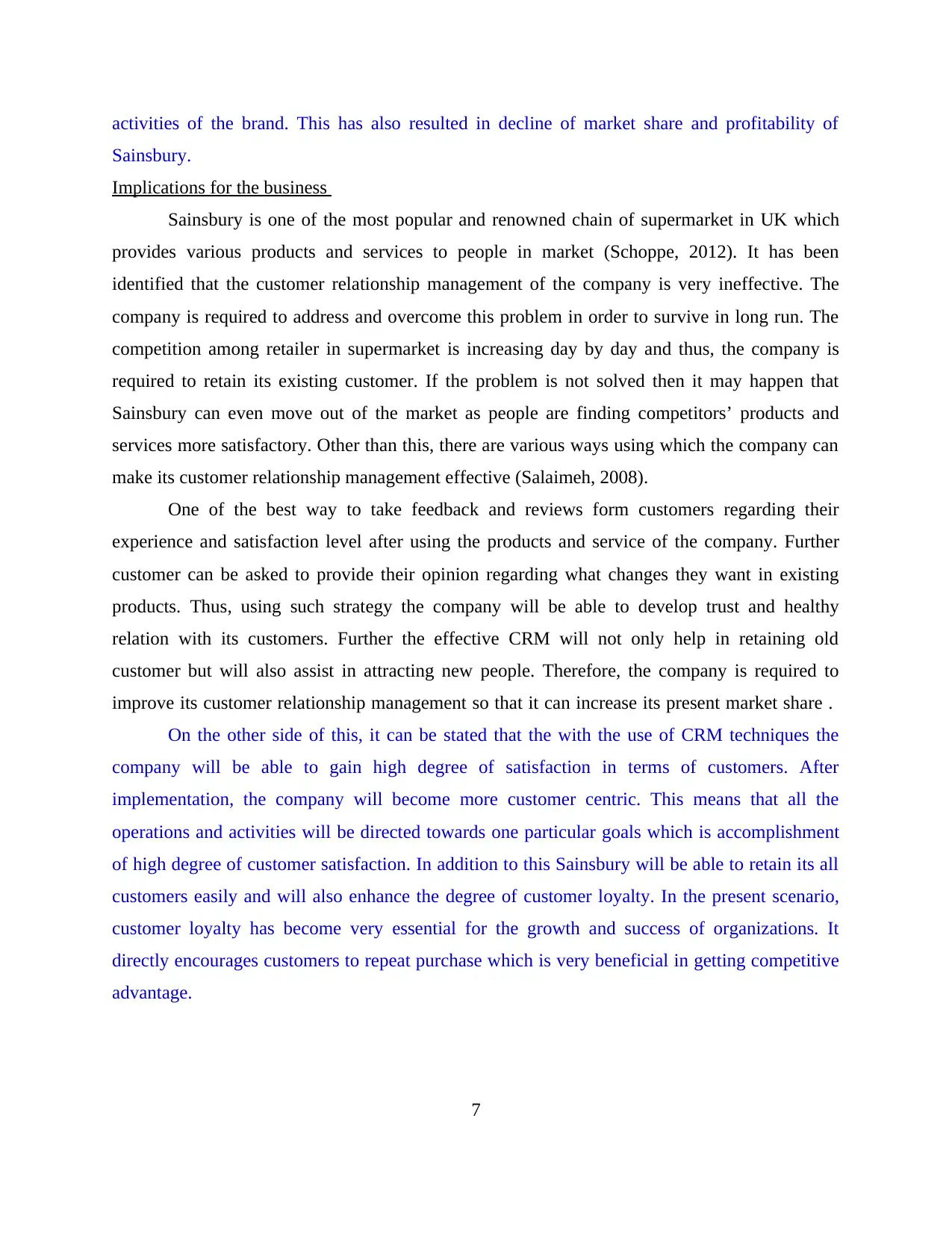
activities of the brand. This has also resulted in decline of market share and profitability of
Sainsbury.
Implications for the business
Sainsbury is one of the most popular and renowned chain of supermarket in UK which
provides various products and services to people in market (Schoppe, 2012). It has been
identified that the customer relationship management of the company is very ineffective. The
company is required to address and overcome this problem in order to survive in long run. The
competition among retailer in supermarket is increasing day by day and thus, the company is
required to retain its existing customer. If the problem is not solved then it may happen that
Sainsbury can even move out of the market as people are finding competitors’ products and
services more satisfactory. Other than this, there are various ways using which the company can
make its customer relationship management effective (Salaimeh, 2008).
One of the best way to take feedback and reviews form customers regarding their
experience and satisfaction level after using the products and service of the company. Further
customer can be asked to provide their opinion regarding what changes they want in existing
products. Thus, using such strategy the company will be able to develop trust and healthy
relation with its customers. Further the effective CRM will not only help in retaining old
customer but will also assist in attracting new people. Therefore, the company is required to
improve its customer relationship management so that it can increase its present market share .
On the other side of this, it can be stated that the with the use of CRM techniques the
company will be able to gain high degree of satisfaction in terms of customers. After
implementation, the company will become more customer centric. This means that all the
operations and activities will be directed towards one particular goals which is accomplishment
of high degree of customer satisfaction. In addition to this Sainsbury will be able to retain its all
customers easily and will also enhance the degree of customer loyalty. In the present scenario,
customer loyalty has become very essential for the growth and success of organizations. It
directly encourages customers to repeat purchase which is very beneficial in getting competitive
advantage.
7
Sainsbury.
Implications for the business
Sainsbury is one of the most popular and renowned chain of supermarket in UK which
provides various products and services to people in market (Schoppe, 2012). It has been
identified that the customer relationship management of the company is very ineffective. The
company is required to address and overcome this problem in order to survive in long run. The
competition among retailer in supermarket is increasing day by day and thus, the company is
required to retain its existing customer. If the problem is not solved then it may happen that
Sainsbury can even move out of the market as people are finding competitors’ products and
services more satisfactory. Other than this, there are various ways using which the company can
make its customer relationship management effective (Salaimeh, 2008).
One of the best way to take feedback and reviews form customers regarding their
experience and satisfaction level after using the products and service of the company. Further
customer can be asked to provide their opinion regarding what changes they want in existing
products. Thus, using such strategy the company will be able to develop trust and healthy
relation with its customers. Further the effective CRM will not only help in retaining old
customer but will also assist in attracting new people. Therefore, the company is required to
improve its customer relationship management so that it can increase its present market share .
On the other side of this, it can be stated that the with the use of CRM techniques the
company will be able to gain high degree of satisfaction in terms of customers. After
implementation, the company will become more customer centric. This means that all the
operations and activities will be directed towards one particular goals which is accomplishment
of high degree of customer satisfaction. In addition to this Sainsbury will be able to retain its all
customers easily and will also enhance the degree of customer loyalty. In the present scenario,
customer loyalty has become very essential for the growth and success of organizations. It
directly encourages customers to repeat purchase which is very beneficial in getting competitive
advantage.
7
Paraphrase This Document
Need a fresh take? Get an instant paraphrase of this document with our AI Paraphraser

REFERENCES
Books and journals
Kenning, P., Plassmann, H. and Ahlert, D., 2007. Applications of functional magnetic resonance
imaging for market research. Qualitative Market Research: An International Journal.
10(2) pp.135 – 152.
Layton, A. G., 2011. Marketing: is management all that there is? Journal of Historical Research
in Marketing. 3(2). pp.194 – 213.
Madsen, K. E. and Pedersen, K., 2013. From price theory to marketing management: Danish
contributions 1930-1960. Journal of Historical Research in Marketing. 5(2). pp.172 –
191.
Jobber, D. and Fahy, J., 2006. Foundation of Marketing. Spain: McGraw-Hill Education.
Kurtz, L. D., 2008. Contemporary Marketing. 13th ed. Cengage Learning
Salaimeh, M., 2008. Marketing Concepts; Segmentation and the Product Development Process.
European Journal of Scientific Research. 23(3). pp. 454-457.
Online
Schoppe, L., 2012. Tactical Tools for Marketing Strategies. [Online]. Available through:
<http://www.fuentek.com/blog/2012/09/tactical-tools-for-techtransfer-marketing-
strategies/>. [Accessed on 30th September 2015].
Sainsbury. 2015. [Online]. Available through: <http://www.google.co.in/url?
sa=t&rct=j&q=&esrc=s&source=web&cd=1&cad=rja&uact=8&ved=0CBwQFjAAahUK
EwiK4aSS257IAhULWI4KHTkTBI4&url=http%3A%2F%2Fwww.sainsburys.co.uk
%2Fshop%2Fgb
%2Fgroceries&usg=AFQjCNGERP22sL7VoVoaf_CRUBUsM9vvlQ&bvm=bv.1036271
16,d.c2E>. [Accessed on 30th September 2015].
Balance sheets. 2015. [Online]. Available through:
<http://annualreport2014.j-sainsbury.co.uk/financial-statements/balance-sheets/>. [Accessed on
12th December 2015].
8
Books and journals
Kenning, P., Plassmann, H. and Ahlert, D., 2007. Applications of functional magnetic resonance
imaging for market research. Qualitative Market Research: An International Journal.
10(2) pp.135 – 152.
Layton, A. G., 2011. Marketing: is management all that there is? Journal of Historical Research
in Marketing. 3(2). pp.194 – 213.
Madsen, K. E. and Pedersen, K., 2013. From price theory to marketing management: Danish
contributions 1930-1960. Journal of Historical Research in Marketing. 5(2). pp.172 –
191.
Jobber, D. and Fahy, J., 2006. Foundation of Marketing. Spain: McGraw-Hill Education.
Kurtz, L. D., 2008. Contemporary Marketing. 13th ed. Cengage Learning
Salaimeh, M., 2008. Marketing Concepts; Segmentation and the Product Development Process.
European Journal of Scientific Research. 23(3). pp. 454-457.
Online
Schoppe, L., 2012. Tactical Tools for Marketing Strategies. [Online]. Available through:
<http://www.fuentek.com/blog/2012/09/tactical-tools-for-techtransfer-marketing-
strategies/>. [Accessed on 30th September 2015].
Sainsbury. 2015. [Online]. Available through: <http://www.google.co.in/url?
sa=t&rct=j&q=&esrc=s&source=web&cd=1&cad=rja&uact=8&ved=0CBwQFjAAahUK
EwiK4aSS257IAhULWI4KHTkTBI4&url=http%3A%2F%2Fwww.sainsburys.co.uk
%2Fshop%2Fgb
%2Fgroceries&usg=AFQjCNGERP22sL7VoVoaf_CRUBUsM9vvlQ&bvm=bv.1036271
16,d.c2E>. [Accessed on 30th September 2015].
Balance sheets. 2015. [Online]. Available through:
<http://annualreport2014.j-sainsbury.co.uk/financial-statements/balance-sheets/>. [Accessed on
12th December 2015].
8
1 out of 8
Related Documents
Your All-in-One AI-Powered Toolkit for Academic Success.
+13062052269
info@desklib.com
Available 24*7 on WhatsApp / Email
![[object Object]](/_next/static/media/star-bottom.7253800d.svg)
Unlock your academic potential
Copyright © 2020–2025 A2Z Services. All Rights Reserved. Developed and managed by ZUCOL.



